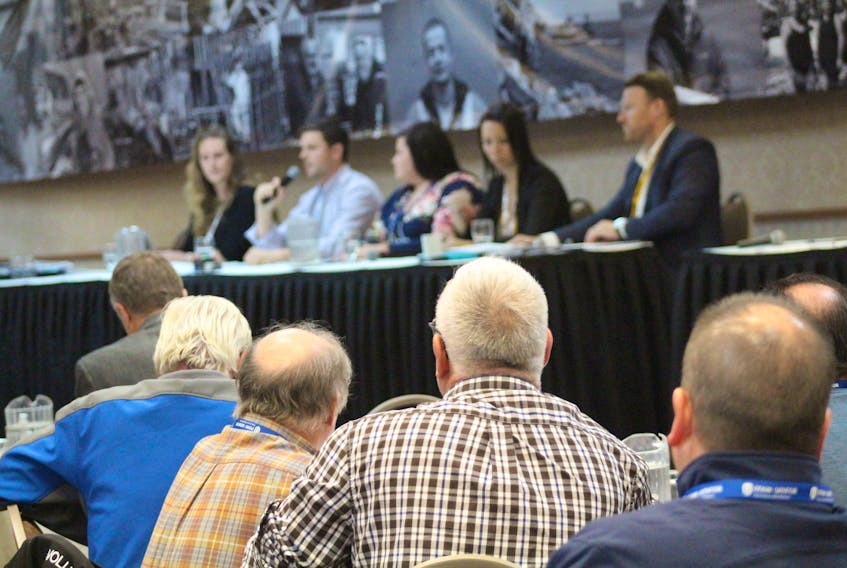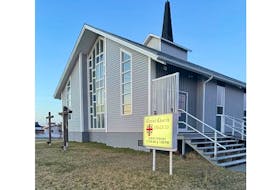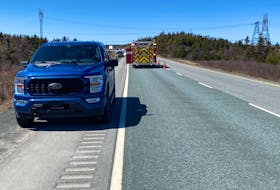GANDER, N.L.
Young fishers feel the high cost of entry and a lack of information about the industry are preventing more of their cohorts from joining their ranks.
In a room filled with a lot of grey, receding, and a few non-existent hairlines, Fish, Food and Allied Workers (FFAW)-Unifor hosted a discussion on the next generation in the fishery in Gander Nov. 6 as part of their wider conference.
Jamie Alyward is one of the younger harvesters in St. Brendan’s, Bonavista Bay.
The 36-year-old spent four years in the fishery after graduating in 2000. Seeing better opportunities out west, he spent more than a decade commuting to Alberta before returning to the fishery in 2016. He feels fortunate to be able to be a part of his family’s enterprise, because unless there’s a family connection, Alyward said it’s near impossible to get a foot in the door because of the cost.
“The investment is almost not worth it, and securing financing is not easy for a young person. I think access to financial help would go a long way in getting new entrants into the fishery.”
-Jamie Alyward

“Thirty years ago, it was go to DFO (Department of Fisheries and Oceans) and get a groundfish license for a few dollars,” he said. “Now, for me to become a fish harvester from scratch, you’re pretty much looking at five years of full-time employment with the fishery and doing courses – professional fish harvester certification – before you’re even allowed to buy an actual license or be fortunate enough to have someone transfer one to you.”
The under 40-foot class inshore fisherman says to buy into an enterprise requires an investment of $200,000-$300,000 for a vessel and licensing, something many potential new entrants just can’t afford.
“The investment is almost not worth it, and securing financing is not easy for a young person,” he said. “I think access to financial help would go a long way in getting new entrants into the fishery.”
Stephanie Lights has been involved in the fishery for the past two years, getting her start with her father fishing cod after being a hairdresser for 13 years. She is currently an apprentice harvester, something, she said, that hasn’t come without its challenges.
“There’s a lot of old school mindframes, not only toward young fishers, female fishers as well,” she said.
Being a woman in the industry, Lights said, often came with comments about how she was working in the boat’s kitchen.
“It wasn’t online, if it was it wasn’t obvious, and every time I needed something in particular, it wasn’t at my fingertips.”
-Stephanie Lights
“When I went on the boat I worked my ass off,” she said. “I boxed thousands and thousands of pounds of crab, and it still boils my blood when they say it, because getting your name out there is a lot of hard work.”
Now, the Port de Graves fisher is looking at moving her education forward and plans to one day own her own license. However, when her father passed earlier this year, finding information on how to move forward proved to be difficult.

“It wasn’t online, if it was it wasn’t obvious, and every time I needed something in particular, it wasn’t at my fingertips,” she said.
Lights believes having information networks in place would assist new entrants.
“I think there should be programs and councils for young people, to build interest and help those just getting into the industry.”
Providing opportunities
While the FFAW didn’t specify any initiatives it has underway to bring youth into the fishery, Neil Jones, a St. Lewis, Labrador, fisherman believes an early introduction is a step in the right direction.
“The onus is on us as parents to get our children back in the fishery,” Jones said.
All three of his children – 13, 10 and eight years old – are involved with the fishery to some degree – from helping on the boat to gutting fish.
“The onus is on us as parents to get our children back in the fishery.”
-Neil Jones
Like others, he moved away, but his connection to the fishery drew him back because it was something his father instilled in him at an early age.
“I’m not driving mine (children) like the old man drove me, but they will know how to do everything when it comes to a boat and a fish,” he said. “I’m going to give them that opportunity, that’s what we as parents have to do.”
Want in on the debate?
Write us a letter to the editor and email it to [email protected]. Be sure to include a name, address and daytime telephone number where the author can be contacted. Letters should be no more than 300 words.









